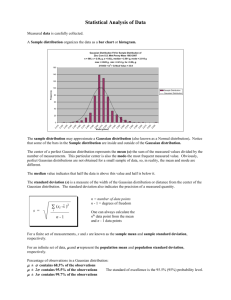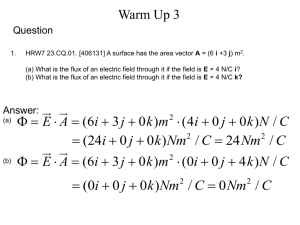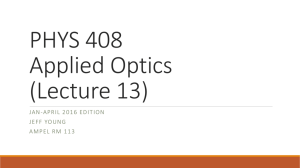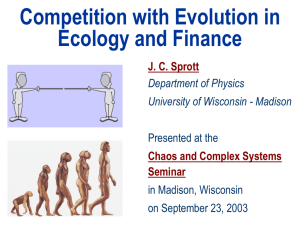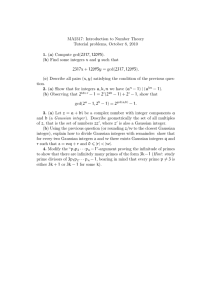Georgian Mathematical Journal 1(1994), No. 4, 353-365 OPTIMAL TRANSMISSION OF GAUSSIAN SIGNALS
advertisement
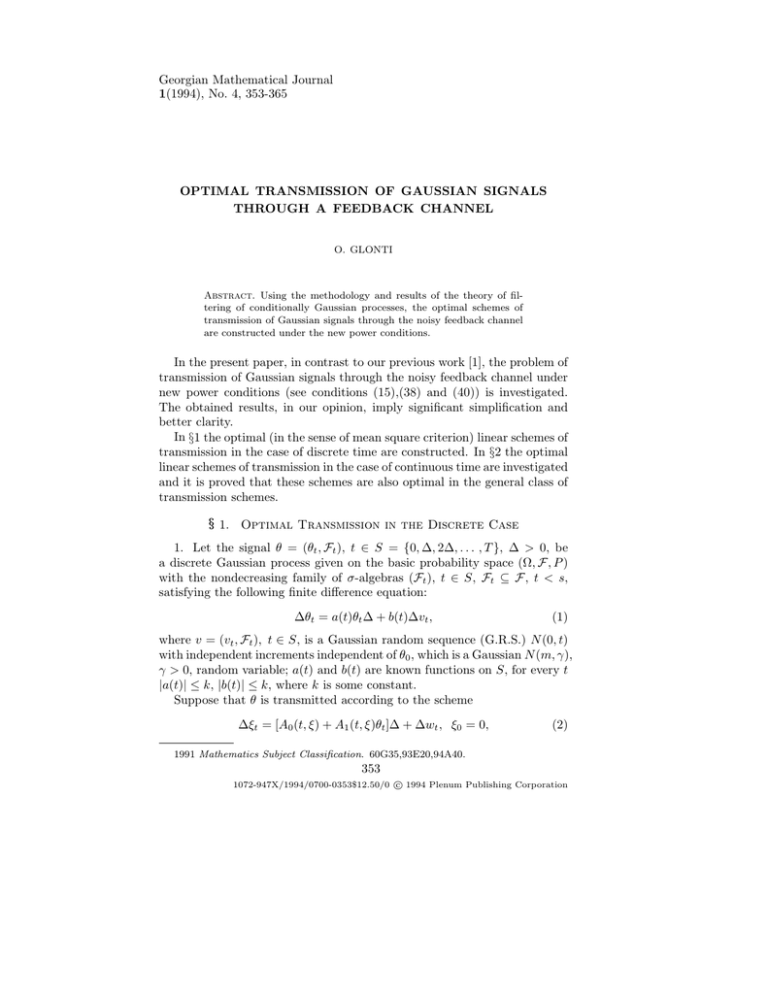
Georgian Mathematical Journal
1(1994), No. 4, 353-365
OPTIMAL TRANSMISSION OF GAUSSIAN SIGNALS
THROUGH A FEEDBACK CHANNEL
O. GLONTI
Abstract. Using the methodology and results of the theory of filtering of conditionally Gaussian processes, the optimal schemes of
transmission of Gaussian signals through the noisy feedback channel
are constructed under the new power conditions.
In the present paper, in contrast to our previous work [1], the problem of
transmission of Gaussian signals through the noisy feedback channel under
new power conditions (see conditions (15),(38) and (40)) is investigated.
The obtained results, in our opinion, imply significant simplification and
better clarity.
In §1 the optimal (in the sense of mean square criterion) linear schemes of
transmission in the case of discrete time are constructed. In §2 the optimal
linear schemes of transmission in the case of continuous time are investigated
and it is proved that these schemes are also optimal in the general class of
transmission schemes.
§ 1. Optimal Transmission in the Discrete Case
1. Let the signal θ = (θt , Ft ), t ∈ S = {0, ∆, 2∆, . . . , T }, ∆ > 0, be
a discrete Gaussian process given on the basic probability space (Ω, F, P )
with the nondecreasing family of σ-algebras (Ft ), t ∈ S, Ft ⊆ F , t < s,
satisfying the following finite difference equation:
∆θt = a(t)θt ∆ + b(t)∆vt ,
(1)
where v = (vt , Ft ), t ∈ S, is a Gaussian random sequence (G.R.S.) N (0, t)
with independent increments independent of θ0 , which is a Gaussian N (m, γ),
γ > 0, random variable; a(t) and b(t) are known functions on S, for every t
|a(t)| ≤ k, |b(t)| ≤ k, where k is some constant.
Suppose that θ is transmitted according to the scheme
∆ξt = [A0 (t, ξ) + A1 (t, ξ)θt ]∆ + ∆wt , ξ0 = 0,
(2)
1991 Mathematics Subject Classification. 60G35,93E20,94A40.
353
c 1994 Plenum Publishing Corporation
1072-947X/1994/0700-0353$12.50/0
354
O. GLONTI
where w = (wt , Ft ), t ∈ S, is a G.R.S. N (0, t) with independent increments
which is independent of θ0 and v. The nonanticipating (with respect to ξ)
functionals A0 (t, ξ) and A1 (t, ξ) define the coding.
The transmission performed according to the scheme (2) is a transmission
of a Gaussian message θ through a noiseless feedback channel which is an
analogue of the additive “White noise” channel in the discrete time case. No
instantaneous feedback is required here (which is essential in the continuous
time), but we assume that the quantization step ∆ is equal to the time of
signal return.
Suppose that the coding functionals A0 and A1 satisfy the condition
E[A0 (t, ξ) + A1 (t, ξ)θt ]2 ≤ p,
(3)
where p is a constant characterizing the energetic potential of the transmitter.
Consider the decoding θ̂ = θ̂t (ξ) satisfying for every t the condition
E θ̂t2 < ∞.
(4)
Such a kind of [(A0 , A1 ), θ̂] forms a class of admissible codings and decodings.
The problem is to find the codings (A∗0 , A1∗ ) and the decodings θ̂∗ optimal
in the sense of the criterion
δ(t) =
inf
A0 ,A1 ,θ̂
E[θt − θ̂t (ξ)]2
(5)
where inf is taken in the class of all admissible [(A0 , A1 ), θ̂].
Theorem 1. During the transmission a discrete Gaussian process described by the finite difference equation (1) according to the transmission
scheme (2) under conditions (3),(4) and the optimal coding functionals A∗0
and A∗1 , have the form
r
t
p
∗
(1 + p∆) 2∆ , A∗0 (t, ξ ∗ ) = −A∗1 (t)m∗t ,
(6)
A1 (t) =
γ
∗
where the optimal decoding θ̂t∗ = m∗t = E[θt |Ftξ ] and the transmitted signal
are defined by the relations
p
(1 + a(t)∆) ∗
∆ξt , m∗0 = m,
∆m∗t = a(t)m∗t ∆ + pγt∗
1 + p∆
r
p
∆ξt∗ =
(θt − m∗t )∆ + ∆wt , ξ0∗ = 0.
γt∗
(7)
(8)
OPTIMAL TRANSMISSION OF GAUSSIAN SIGNALS
355
The minimal error of message reproduction has the following form:
δ(t) = γt∗ = γ
Y
t−∆
t
(1 + a(k)∆)2 (1 + p∆)− ∆ +
k=0
+
t−∆
X
k=0
(b2 (k)∆)
t−∆
Y
s=k+∆
t−k−2∆
(1 + a(s)∆)2 (1 + p∆)− ∆ .
Proof. For the given A0 and A1 it is known that θ̂t = mt = E(θt |Ftξ ). Hence
δ(t) = inf (A0 ,A1 ) E(θt − mt )2 = inf (A0 ,A1 ) Eγt .
In order to find mt and γt = E[(θt − mt )2 |Ftξ ] we shall use filtering
equations for the conditionally Gaussian random sequence (see [1] or [2]).
The rest of the proof is similar to that of the theorem on the optimal
scheme for the transmission of Gaussian processes through a noiseless feedback channel in continuous time (see [2]).
2. It is natural to investigate the case of Gaussian signal transmission
when white noise is imposed on the back signal, i.e., the message is transmitted according to the scheme
e + σ(t)∆wt , ξ0 = 0,
∆ξt = A(t, θ, ξ)∆
(9)
∆ξt = [A0 (t)ξet + A1 (t)θt ]∆ + σ(t)∆wt , ξ0 = 0,
(10)
ξet = Π(t, ξ) + ηt .
(11)
∆ηt = c(t)ηt ∆ + d(t)∆w̄t ,
(12)
where the back signal ξet has the form, say, ξet = ξt + ηt or ξet = Π(t, ξ) + ηt ,
where Π(t, ξ) is some nonanticipating functional and ηt is the noise in the
back channel.
We shall specify the problem under consideration.
Let the signal θ = (θt , Ft ), t ∈ S, be a discrete Gaussian process described by the equation (1).
Assume that θ is transmitted according to the scheme
where the functions A0 and A1 define the coding.
The back signal has the form
Here Π(t, ξ) is a transformator of the back message and ηt is the noise in
the back channel governed by the finite difference equation
where w̄ = (w̄t , Ft ), t ∈ S, is a G.R.S. N (0, t) with independent increments,
for every t |c(t)| ≤ L and |d(t)| ≤ L, where L is some constant.
356
O. GLONTI
Denote
(1)
mt
(1)
γt
(2)
= mt = E[θt |Ftξ ], mt
(2)
= γt = E[(θt − mt )2 |Ftξ ],
(1,2)
γt
(2,1)
= γt
(2)
= E[(ηt − mt )2 |Ftξ ],
(2)
= E[(θt − mt )(ηt − mt )|Ftξ ],
2
γ
et =
γt
= E[ηt |Ftξ ],
(2)
γt
−
γt
(1,2)
γt
(1,2)
,
γ̂t =
γt
.
γt
The problem is to find the codings (A∗0 , A∗1 ), decodings θ̂∗ = (θ̂t∗ (ξ ∗ )),
t ∈ S, and the transformator Π∗ optimal in the sense of the square criterion
δ(t) =
inf
A0 ,A1 ,Π,θ̂
E[θt − θ̂t (ξ)]2 ,
(13)
where inf is taken in the class of admissible A0 , A1 , Π, θ̂ for which the power
condition1
E[A0 (t)ξet + A1 (t)θt ]2 ≤ p(t),
A20 (t)e
γt
(14)
≥ q(t)
(15)
holds where p(t) and q(t) are summable functions on S characterizing the
changes of the energetic transmitter potential, and q(t) ≤ p(t), t ∈ S. Let
E θ̂t2 < ∞.
(16)
Theorem 2. When the Gaussian random sequence θ = (θt , Ft ), t ∈ S,
governed by the finite difference equation (1) is transmitted according to the
scheme of transmission (10)–(12) through a noisy feedback channel under
conditions (14)–(16), then the optimal [in the sense of square criterion (13)]
coding functions A∗0 , A∗1 , decoding functional, θ̂∗ and transformator of the
back message Π∗ have the form
q(t) 1
p(t) − q(t) 12
A1∗ (t) = − ∗ 2 γ̂t∗ +
,
et
γt∗
γ
A∗ (t)
∗(2)
Π∗ (t, ξ) = −mt − ∗1 m∗t , θ̂t∗ (ξ ∗ ) = m∗t ,
A0 (t)
A∗0 (t) =
q(t) 12
,
et∗
γ
1
∆m∗t = a(t)mt∗ ∆ + (1 + a(t)∆)[γt∗ (p(t) − q(t))] 2 ×
×(σ 2 (t) + p(t)∆)−1 ∆ξt∗ ,
1 The
(17)
m0∗ = m.
fact that condition (15) is the power condition indeed will be shown at the end
of the section.
OPTIMAL TRANSMISSION OF GAUSSIAN SIGNALS
357
The optimal transmission has the following form:
∆ξt∗ =
q(t) 12 ∗ p(t) − q(t) 12
q(t) 21
∗(2)
m
−
)
+
γ̂t +
×
(η
−
t
t
et∗
et∗
γt∗
γ
γ
(18)
×(θt − m∗t ) ∆ + σ(t)∆wt , ξ0∗ = 0,
∗(2)
where mt
∗(2)
∆mt
satisfies the finite difference equation
∗(2)
= c(t)mt
1
(2)
∗(2)
×(σ 2 (t) + p(t)∆)−1 ∆ξt∗ , m0
(γ
∗(2)
1
∆ + (1 + c(t)∆){γ̂t∗ [γt∗ (p(t) − q(t))] 2 + [q(t)γ̂t∗ ] 2 } ×
∗(1,2) 2
)
γ
= m(2) = Eη0
∗(1,2)
− t γ∗
et∗ = γt
and γ̂t∗ = tγ ∗ are defined by the filtering
and γ
t
t
equations (19)–(23) given below, where A∗0 and A1∗ are substituted from (17).
The minimal message reproduction error δ(t) has the form
δ(t) = γt∗ = γ
t−∆
Y
(1 + a(k)∆)2 (σ 2 (k) + q(k)∆)(σ 2 (k) + p(k)∆)−1 +
k=0
+
t−∆
X
k=0
b2 (k)
t−∆
Y
(1+a(m)∆)2 (σ 2 (m)+q(m)∆)(σ 2 (m)+p(m)∆)−1 .
m=k+∆
Corollary. Let a(t) = b(t) ≡ 0, i.e., according to the scheme (10)–(12),
a Gaussian N (m, γ), γ > 0, random variable θ is transmitted. Then the
reproduction error δ(t) is
δ(t) = γ
t−∆
Y
k=0
In this case
et∗
γ
and
γ̂t∗
1+
q(k)
p(k) −1
∆ 1+ 2
∆
.
2
σ (k)
σ (k)
satisfy the following finite difference equations:
γt∗
∆e
= d2 (t) + γ
e0∗ = 0,
et∗ (c(t)σ 2 (t) − q(t))(σ 2 (t) + q(t)∆)−1 , γ
∆
∆γ̂t∗
= γ̂t∗ [c(t)σ 2 (t) − q(t)γt∗ + q(t)(1 + c(t)∆)] −
∆
q(t) 1 p(t) − q(t) 21 ∗ 2
−(1 + c(t)∆) ∗ 2
γ
et [σ (t) + q(t)∆]−1 , γ̂0∗ = 0.
γt
γt∗
Proof of the Theorem. It can be easily seen that
δ(t) =
inf
(A0 ,A1 ,Π)
Eγt =
inf
(A0 ,A1 ,Π)
γt .
Rewrite (10) in the following form:
∆ξt = [A0 (t)Π(t, ξ) + A0 (t)ηt + A1 (t)θt ]∆ + σ(t)∆wt , ξ0 = 0.
358
O. GLONTI
Then one can see that the equation of optimal filtering of a partially observable conditionally Gaussian process (θet , ξt ), t ∈ S, with an unobservable
component θet = (θt , ηt ) (see [1] or [2]) leads to the following closed system
of finite difference equations:
(1,2)
∆mt = a(t)mt ∆ + (1 + a(t)∆)(A1 (t)γt + A0 (t)γt
×[σ 2 (t) + (A21 (t)γt +
(1,2)
2A1 (t)A0 (t)γt
×[∆ξt − (A0 (t)(Π(t, ξ) +
(2)
∆mt
(2)
mt )
+
+ A1 (t)mt )∆],
(1,2)
(2)
= c(t)mt ∆ + (1 + c(t)∆)(A1 (t)γt
(1,2)
[σ 2 (t) + (A12 (t)γt + 2A1 (t)A0 (t)γt
(2)
×
m0 = m,
(19)
(2)
+ A0 (t)γt ) ×
(2)
+ A20 (t)γt )∆]−1 ×
×[∆ξt − (A0 (t)(Π(t, ξ) + mt ) + A1 (t)mt )∆],
(1)
∆γt
)×
(2)
A20 (t)γt )∆]−1
m(2) = m,
(20)
(1)
(1)
= b2 (t) + a2 (t)γt ∆ + 2a(t)γt −
∆
(1,2)
(1)
−(1 + a(t)∆)2 (A1 (t)γt + A0 (t)γt )2 [σ 2 (t) +
(1)
+(A12 (t)γt
(1,2)
+ 2A1 (t)A0 (t)γt
(1)
γ0
(2)
+ A02 (t)γt )∆]−1 ,
= γ,
(2)
∆γt
(21)
(2)
(2)
= d2 (t) + c2 (t)γt ∆ + 2c(t)γt −
∆
(1,2)
(2)
−(1 + c(t)∆)(A1 (t)γt
+ A0 (t)γt )2 [σ 2 (t) +
(1)
+(A12 (t)γt
(1,2)
+ 2A1 (t)A0 (t)γt
(2)
γ0
(1,2)
γt
(1,2)
(2)
+ A20 (t)γt )∆]−1 ,
= γ2 ,
(22)
(1,2)
− (1 + a(t)∆)(1 + c(t)∆) ×
+ c(t)γt
= a(t)γt
∆
(1,2)
(1)
(1,2)
(2)
+ A0 (t)γt )[σ 2 (t) +
×(A1 (t)γt + A0 (t)γt )(A1 (t)γt
(1)
+A21 (t)γt
(1,2)
+ 2A1 (t)A0 (t)γt
(2)
+ A02 (t)γt )∆]−1 .
Equation (21) can be reduced to the form
γt =
Y
t−∆
(1 + a(k)∆)2 (σ 2 (k) + A20 (k)e
γk ∆)[σ 2 (k) +
k=0
+(A21 (k)γk
×
X
t−∆
l=0
(1,2)
+ 2A1 (k)A0 (k)γk
(2)
+ A02 (k)γk )∆]−1 ×
l
Y
(1 + a(m)∆)2 (σ 2 (m) + A02 (m)e
b2 (l)
γm ∆) ×
m=0
(23)
OPTIMAL TRANSMISSION OF GAUSSIAN SIGNALS
(1,2)
×[σ 2 (m) + (A21 (m)γm + 2A1 (m)A0 (m)γm
+
2
(2)
−1 −1
+γ .
+A0 (m)γm )∆]
359
(24)
Using inequality (15) and the inequality resulting from (14)
(1,2)
A12 (t)γt + 2A1 (t)A0 (t)γt
(2)
+ A02 (t)γt
≤p
(25)
we obtain from (24) E(θt − mt )2 = γt ≥ ψ(t), where
ψ(t) =
Y
t−∆
k=0
×
(1 + a(k)∆)2 (σ 2 (k) + q(k)∆)(σ 2 (k) + p(k)∆)−1 ×
X
t−∆
l=0
l
Y
(1 + a(m)∆)2 (σ 2 (m) + q(m)∆) ×
b2 (l)
m=0
×(σ 2 (m) + p(m)∆)−1
and since ψ(t) is a known function, we have
−1
+γ
δ(t) ≥ ψ(t)
(26)
for all t ∈ S.
The equality in (26) is obtained when
A0 (t)e
γt = q(t),
A21 (t)γt +
(1,2)
2A1 (t)A0 (t)γt
+
(2)
A20 (t)γt
(27)
= p(t).
(28)
Since
p(t) ≥ E(A0 (t)ξet + A1 (t)θt )2 = E[A0 (t)Π(t, ξ) +
(2)
(1,2)
+A0 (t)mt + A1 (t)mt ]2 + A21 (t)γt + 2A1 (t)A0 (t)γt
+ A02 (t)γt (2),
(28) implies (P -a.s.)
(2)
A0 (t)Π(t, ξ) + A0 (t)mt + A1 (t)mt = 0.
(29)
Consequently, (27),(28) and (29) are the relations from which optimal
codings (A∗0 , A∗1 ) and the transformator Π∗ are obtained. This completes
the proof of the theorem.
Remark. As can be seen from relation (17), the optimal transformator
of the back message Π∗0 is constructed in such a way that the back message
is multiplied by the value of some deterministic function of time at the
(2)
moment t and mt with a negative sign, i.e., the noise ηt is compensated
(2)
by the best (in the sense of the square criterion) estimate mt = E[ηt |Ftξ ]
(see optimal transmission scheme (18)).
360
O. GLONTI
To conclude this section we can show that condition (15) is indeed a
power-type condition.
It can be easily seen that
(2)
E(A0 (t)ξet + A1 (t)θt )2 = E[A0 (t)Π(t, ξ) + A0 (t)mt + A1 (t)mt ]2 +
(2)
+A02 (t)γt
(1,2)
+ 2A0 (t)A1 (t)γt
(2)
+ A21 (t)γt = E[A0 (t)Π(t, ξ) + A0 (t)mt +
(1,2)
γt + (A20 (t)γt
+A1 (t)mt ]2 + A02 (t)e
+ A1 (t)γt )2 γt−1
(30)
and since A02 (t)e
γt ≥ q(t), (30) implies
E[A0 (t)ξet + A1 (t)θt ]2 ≥ q(t).
(31)
Consequently (15) implies power condition (31).
§ 2. Optimal transmission in a continuous case
Consider the following problem. A Gaussian message θ is transmitted
through an additive white noise instantaneous feedback channel described
by the following stochastic differential equation:
e + σ(t)dwt
dξt = A(t, θ, ξ)dt
(32)
ξet = Π(t, ξ) + ηt
(33)
dθt = a(t)θt dt + b(t)dvt ,
(34)
where w = (wt , Ft ) is a Wiener process. In contrast to the traditional
schemes (see, e.g., [2]–[6]), the feedback here is not assumed to be noiseless.
The functional A in (32) defines the coding, and the back signal ξe has
the following form:
where Π is the transformator of the back signal, η is a noise in the back
channel.
In this section optimal transmission schemes are constructed under cere = A0 (t)ξet + A1 (t)θt
tain power restrictions in a linear case when A(t, θ, ξ)
and it is proved that these particular linear schemes are also optimal in the
general class given by (32),(33).
1. Let the transmitted message θ = (θt , Ft ), t ∈ [0, T ], be a Gaussian
process described by the stochastic differential equation
where v = (vt , Ft ) is a Wiener process independent of the Gaussian N (m, γ),
γ > 0, random variable θ0 , and |a(t)| ≤ k, |b(t)| ≤ k, where k is some
constant.
Suppose that θ is transmitted according to the following linear scheme:
dξt = [A0 (t)ξet + A1 (t)θt ]dt + σ(t)dwt , ξ0 = 0,
(35)
OPTIMAL TRANSMISSION OF GAUSSIAN SIGNALS
361
where w = (wt , Ft ) is a Wiener process independent of v; A0 (t) and A1 (t)
are the coding functions, σ(t) > 0. The back signal ξe has the form (33).
The noise in the back channel η admits the stochastic differential
dηt = ā(t)ηt dt + b̄(t)dw̄t
(36)
where w̄ = (w̄t , Ft ) is a Wiener process independent of w and v and of the
Gaussian N (m2 , γ2 ), γ2 > 0, random variable η0 , |ā(t)| ≤ k, |b̄(t)| ≤ k.
A class of admissible codings, transformator, and decodings is formed by
such [(A0 , A1 ), Π, θ̂] for which the following conditions are satisfied:
1) the stochastic differential equation (35) has a unique strong solution,
supt∈[0,T ] |Ai (t)| < ∞, i = 0, 1;
(37)
2) E[A0 (t)ξet + A1 (t)θt ]2 ≤ p(t),
A20 (t)e
γt ≥ q(t),
(38)
where p(t) and q(t) are some functions integrable on [0, T ] and, for every t,
q(t) ≤ p(t).
Let
∆(t) = inf E[θt − θ̂t (ξ)]2 ,
(39)
where inf is taken in the class of admissible [(A0 , A1 ), Π, θ̂].
Theorem 3. When a Gaussian random process θt governed by a stochastic differential equation (34) is transmitted through a noisy feedback channel
(35),(33),(36) under conditions 1) and 2) optimal in the sense of the square
criterion (39), the coding functions A∗0 , A∗1 and the transformator of the
back message Π∗ have the following form2
A0∗ (t) =
q(t) 21
q(t) 1
p(t) − q(t) 12
, A1∗ (t) = − ∗ 2 γ̂t +
,
∗
γ
et
γ
et
γt∗
A∗ (t)
∗(2)
Π∗ (t, ξ ∗ ) = −mt + ∗0 m∗t ,
A1 (t)
where γt∗ is equal to the minimal message reproduction error
Z t
Z t
(p(s) − q(s))
∗
a(s)ds −
∆(t) = γt = γ exp{2
ds} +
σ 2 (s)
0
0
Z t
Z t
Z t
(p(u) − q(u))
a(u)ds −
+
du}ds,
b(s) exp{2
σ 2 (u)
s
s
0
et∗ and γ̂t∗ are defined by the following equations:
and γ
de
γt∗
q(t)
= b̄2 (t) + 2e
γt∗ ā(t) − 2
+ γ̂t∗ (b2 (t) + 2a(t)γt∗ ), γ
e0∗ = γ2 ,
dt
σ (t)
2 The
notation of §1 is used.
362
O. GLONTI
dγ̂t∗
q(t)
γ
et
= γ̂t∗ ā(t) − 2
− b2 (t) − 2a(t)γt∗ − A∗1 (t)A∗0 (t) 2 , γ̂0∗ = 0.
dt
σ (t)
σ (t)
The optimal decoding m∗t satisfies the following stochastic differential
equation:
1
dm∗t = a(t)m∗t dt + [γt∗ (p(t) − q(t))] 2 σ −2 (t)dξt∗ , m∗t = m.
The optimal transmission is
dξt∗ =
or
p(t) − q(t) 12
q(t) 21 ∗ q(t) 12
ξet + −
γ̂t +
θt + σ(t)dwt
∗
∗
γ
et
γ
et
γt∗
q(t) 21
q(t) 21 ∗
∗(2)
(ηt − mt ) + −
γ̂t +
∗
et
et∗
γ
γ
p(t) − q(t) 12
(θt − m∗t ) dt + σ(t)dwt , ξ0∗ = 0,
+
∗
γt
dξt∗ =
∗(2)
where mt
is defined by the equation
∗(2)
dmt
∗(2)
= ā(t)mt
1
1
dt + {γ̂t∗ [γt∗ (p(t) − q(t))] 2 +
∗(2)
+[q(t)e
γt∗ ] 2 σ −2 (t)dξt∗ , m0
= m2 .
The proof of the theorem is similar to that of an analogous theorem
(Theorem 2, §1) for the discrete case, and the equations of nonlinear filtering
of conditionally Gaussian type processes (see [2]) are used.
Corollary. When a Gaussian N (m, γ), γ > 0, random variable θ is
transmitted through the channel (35),(33),(36), the minimal message reproduction error is
h Z t (p(s) − q(s))ds i
.
∆(t) = γ exp −
σ 2 (s)
0
Now we shall consider the simplest case of a Gaussian N (m, γ) random
variable θ transmission through a noisy feedback channel (32),(33) with
e = ξet + A(t)θ. Let σ(t) ≡ 1.
A(t, θ, ξ)
For simplicity we assume that ηt = b̄w(t), where b̄ is some constant. Then
the optimization problem is simplified and instead of obtaining optimal
A0 , A1 , Π, θ̂ as in Part 1 of Section 1 we must find optimal A, Π, θ̂.
The necessity of condition (38) is eliminated but it should be required
that p(t) ≥ γ
et , t ∈ [0, T ].
The optimal A∗ , Π∗ , and θ̂∗ will have the following form:
A∗ (t) = −γ̂t∗ +
p(t) − γ
et 12
,
∗
γt
OPTIMAL TRANSMISSION OF GAUSSIAN SIGNALS
∗(2)
Π∗ (t, ξ ∗ ) = −mt
p − γ
et 12 ∗
mt ,
+ γ̂t∗ −
∗
γt
363
θ̂t∗ = θ̂t∗ (ξ ∗ ) = mt∗ ,
where m∗t admits the representation
1
dm∗t = [γt∗ (p(t) − γ
et )] 2 dξt∗ , m0∗ = m
and γ
et and γ̂t are found from the relations
while
de
γt
= b̄2 − γ
et2 , γ
e0 = 0, γ̂t = −
dt
∗(2)
mt
Z
0
t
p(s) − γ
es 12
γ
es ds,
γs
is found from the stochastic differential equation
∗(2)
dmt
1
et }dξt∗ ,
= {γ̂t∗ [γt∗ (p(t) − γ
et )] 2 + γ
∗(2)
m0
= 0.
The minimal message reproduction error is
Z t
∆(t) = γ exp −
(p(s) − γ
es )ds .
0
In the case b̄ = 1 we have
e2t − 1
,
e2t + 1
Z t
∆(t) = γ exp −
p(s)ds ch t,
γ
et =
0
where ch t is the hyperbolic cosine.
In the case b̄ = 0, i.e., when the noise η in the back channel is absent, we
have
Z t
∆(t) = γ exp −
p(s)ds ,
0
which coincides with the transmission through a feedback noiseless channel
(see [2]) and our optimal Π and A coincide with the optimal codings A0 and
A1 by using the notation of [2], i.e., in this case the transformator Π can be
placed in the coding device by virtue of a noiseless feedback.
2. Consider the transmission of the Gaussian process described by the
stochastic differential equation (34) through the channel (32),(33). Let
e θt ,ξ ], F θt ,ξ = σ{θt , ξs , s ≤ t},
e θt , ξ) = E[A(t, θt , ξ)|F
A(t,
t
e ξ ].
Ā(t, ξ) = E[A(t, θt , ξ)|F
t
Assume that the following conditions are satisfied:
1) Equation (1) has a unique strong solution,
e ≤ p(t),
2) EA2 (t, θt , ξ)
e
e θt , ξ)]2 ≥ q(t)
E[A(t, θt , ξ) − A(t,
(40)
364
O. GLONTI
where p(t) and q(t) are some functions integrable on [0, T ] and for every t
p(t) ≥ q(t).
e ξ)
Let IT (θ, ξ) be the mutual information of signals θ and ξ and let IT (θ,
be the mutual information of θe = (θt , ηt ) and ξ, t ∈ [0, T ].
e ξ) have the folLemma 1. The mutual informations IT (θ, ξ) and IT (θ,
lowing forms (see [7]):
Z
1 T
e2 (t, θt , ξ) − Ā2 (t, ξ)]σ −2 (t)dt,
IT (θ, ξ) =
(41)
E[A
2 0
Z T
e ξ)−IT (θ, ξ) = 1
e A(t,
e θt , ξ)]2 σ −2 (t)dt.
IT (θ,
E[A(t, θt , ξ)−
(42)
2 0
Corollary. Under conditions 1) and 2) we have
Z T
Z
p(t)
1 T q(t)
e
e ξ) ≤ 1
I
dt,
I
(
θ,
ξ)
−
(θ,
ξ)
≥
dt.
IT (θ,
T
T
2 0 σ 2 (t)
2 0 σ 2 (t)
Let It = sup It (θ, ξ), where sup is taken in the class of all admissible
transmission schemes (32),(33), i.e. schemes for which conditions 1) and 2)
are satisfied. Then from the corollary of the lemma we have
Z
1 t p(s) − q(s)
It ≤
ds.
2 0
σ 2 (s)
e = A0 (t)ξet + A1 (t)θt , since Ā(t, ξ) = 0 we
For the linear case A(t, θt , ξ)
have
Z
Z
1 t e2
1 t p(s) − q(s)
∗
∗
It (θ, ξ ) =
E A (s, θs , ξ )ds =
ds.
2 0
2 0
σ 2 (s)
Hence the following theorem is true.
Theorem 4. The optimal codings A∗0 , A∗1 , the decoding mt∗ and the transformator Π∗ constructed in Theorem 3 are also optimal in the sense of maximum of mutual information.
3. Finally we prove the following
Theorem 5. When a Gaussian N (m, γ), γ > 0, random variable θ is
transmitted according to the transmission scheme (32),(33) under conditions
1) and 2), the minimal reproduction error δ(t) = inf (A,Π,θ̂) E(θ − θ̂t (ξ))2 has
the following form:
n Z t
o
δ(t) = ∆(t) = γ exp −
(p(s) − q(s))σ −2 ds ,
0
OPTIMAL TRANSMISSION OF GAUSSIAN SIGNALS
365
where ∆(t) is the minimal message reproduction error for the optimal linear
transformation constructed in Theorem 3, i.e. among all admissible schemes
the transmission constructed in Theorem 3 is optimal in the sense of the
square criterion.
Proof. Since δ(t) ≤ ∆(t), the theorem will be proved if we show that
n Z t
o
δ(t) ≥ γ exp −
(p(s) − q(s))σ −2 ds .
(43)
0
Let θ̂ = θ̂t (ξ) be some decoding. Then by Lemma 16.8 from [2] we have
E(θ − θ̂t (ξ))2 ≥ γe−2I(θ,θ̂t (ξ)) .
But I(θ, θ̂t (ξ)) ≤ It (θ, ξ), and according to Theorem 4
Z
1 t
It (θ, ξ) ≤ It (θ, ξ ∗ ) =
(p(s) − q(s))σ −2 (s)ds.
2 0
Hence inequality (43) holds and Theorem 5 is true.
References
1. O.A.Glonti, Investigations in the theory of conditionally Gaussian
processes.(Russian) Metsniereba, Tbilisi, 1985.
2. R.Sh.Liptser and A.N.Shiryayev, Statistics of random processes: I. General Theory, II. Applications. Springer, Berlin, 1977, 1978 (transl. from
Russian, Nauka, Moscow, 1974).
3. S.Ihara, Coding theory in white Gaussian channel with feedback. J.
Multivariate Anal. 4(1974), 74-87.
4. S.Ihara, Coding theory in Gaussian channel with feedback. II. Evaluation of the filtering error. Nagoya Math. J. 58(1975), 127-147.
5. P.K.Katyshev, Transmission of Gaussian process over a feedback channel. (Russian) Problemi Peredachi Informatsii 12(1976), No. 1, 112-118.
6. R.S.Liptser, Optimal coding and decoding in transmission of Gaussian Markov message through channel with noiseless feedback. (Russian)
Problemi Peredachi Informatsii 10(1974), No. 4, 3-15.
7. O.A.Glonti, On mutual information of signals in the case of transmission over a “noisy” feedback channel. (Russian) Teor. Veroyatnost. i
primenen. 23(1978), No. 2, 395-397; English translation: Theory Probab.
Appl. 23(1978), 377-379.
(Received 25.12.1992)
Author’s address:
Laboratory of Probabilistic and Statistical Methods,
I.Javakhishvili Tbilisi State University,
150a David Agmashenebeli Ave., Tbilisi 380012
Republic of Georgia
